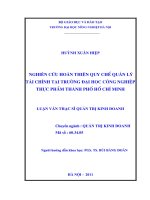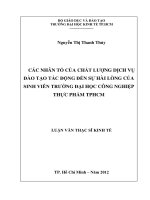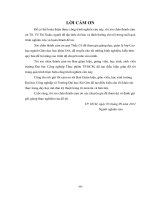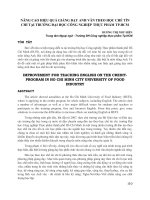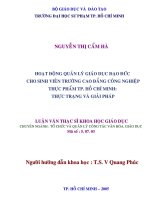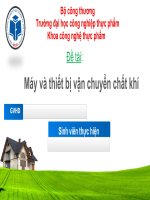Vocabulary English of technology words - Trường Đại học Công nghiệp Thực phẩm Tp. Hồ Chí Minh
Bạn đang xem bản rút gọn của tài liệu. Xem và tải ngay bản đầy đủ của tài liệu tại đây (479.78 KB, 20 trang )
<span class='text_page_counter'>(1)</span><div class='page_container' data-page=1>
<b>SADDLEB</b>
<b>A</b>
<b>CK</b>
<b>S</b>
<b>CIENCE</b>
<b>AND</b>
<b>T</b>
<b>ECHNOLOGY</b>
<b>W</b>
<b>ORDS</b>
<b>V</b>
<b>OCAB</b>
<b>ULAR</b>
<b>Y</b>
<b>I</b>
<b>N</b>
<b>C</b>
<b>ONTEXT</b>
</div>
<span class='text_page_counter'>(2)</span><div class='page_container' data-page=2>
◆ <b>Science in the News</b> ◆ <b>The Natural World</b>
◆ <b>Computers and the Net</b> ◆ <b>Observations and Experiments</b>
<b>VOCABULARY</b>
<b>SCIENCE AND</b>
<b>TECHNOLOGY</b>
<b>WORDS</b>
<b>VOCABULARY</b>
in context
<b>VOCABULARY</b>
</div>
<span class='text_page_counter'>(3)</span><div class='page_container' data-page=3>
2
Development and Production: Laurel Associates, Inc.
Cover Design: Elisa Ligon
Interior Illustrations: Katherine Urrutia, Debra A. LaPalm, C. S. Arts
Copyright © 2002 by Saddleback Educational Publishing. All rights reserved.
No part of this book may be reproduced in any form or by any means, electronic
or mechanical, including photocopying, recording, or by any information storage
and retrieval system, without the written permission of the publisher.
ISBN-10: 1-56254-400-4
ISBN-13: 978-1-56254-400-3
eBook: 978-1-60291-484-1
Printed in the United States of America
07 06 05 04 03 9 8 7 6 5 4 3 2 1
Three Watson
Irvine, CA 92618-2767
E-Mail:
Website: www.sdlback.com
E
VERYDAY
L
IVING
W
ORDS
H
ISTORY
AND
G
EOGRAPHY
W
ORDS
M
EDIA
AND
M
ARKETPLACE
W
ORDS
M
USIC
, A
RT
,
AND
L
ITERATURE
W
ORDS
S
CIENCE
AND
T
ECHNOLOGY
W
ORDS
W
ORKPLACE
AND
C
AREER
W
ORDS
in context
<b>VOCABULARY</b>
iinn ccoonntteexxtt
</div>
<span class='text_page_counter'>(4)</span><div class='page_container' data-page=4>
▼
<b>Introduction</b>
...
4UNIT 1
<b>Preview</b> ... 5<b>LESSON</b>
<b>1</b>
<b>Unit 1 Glossary</b> ... 6<b>2</b>
How Does SunlightProduce Vitamin D? ... 9
<b>3</b>
<i>Waves, Surf, Seas,</i>and <i>Swells</i>: What’s the
Difference? ... 12
<b>4</b>
Some Surprising FactsAbout Bones ... 15
<b>5</b>
<i>Science in the News:</i> A <i>Very</i>Long-Term Experiment ... 18
<b>6</b>
Have You Ever Seen aSun Dog? ... 21
<b>7</b>
<i>Science in the News:</i> TheDangers of Mercury ... 24
▼ <b>Unit 1 Review</b> ... 27
UNIT 2
<b>Preview</b> ... 30<b>LESSON</b>
<b>1</b>
<b>Unit 2 Glossary</b> ... 31<b>2</b>
What’s a <i>Hertz</i>? ... 34<b>3</b>
What CausesPrecipitation? ... 37
<b>4</b>
Try It Yourself: Make aStanding Wave ... 40
<b>5</b>
Carbon: A CommonElement ... 43
<b>6</b>
In Pursuit of Knowledge:The Scientific Method ... 46
<b>7</b>
<i>Science in the News:</i> Rewritingthe Record Books ... 49
▼ <b>Unit 2 Review</b> ... 52
<b>CONTENTS</b>
UNIT 3
<b>Preview</b> ... 55<b>LESSON</b>
<b>1</b>
<b>Unit 3 Glossary</b> ... 56<b>2</b>
Today’s Weather Forecast:A National Overview ... 59
<b>3</b>
Try It Yourself: MakingMold ... 62
<b>4</b>
Two Kinds of Research:Basic and Applied ... 65
<b>5</b>
How Does a Radio Work? .. 68<b>6</b>
The Amazing Rhino ... 71<b>7</b>
<i>Science in the News:</i>Avoiding Potholes on the
Information Highway ... 74
▼ <b>Unit 3 Review</b> ... 77
UNIT 4
<b>Preview</b> ... 80<b>LESSON</b>
<b>1</b>
<b>Unit 4 Glossary</b> ... 81<b>2</b>
Rabbits and Hares: What’sthe Difference? ... 84
<b>3</b>
Animal Intelligence ... 87<b>4</b>
Why Are Deserts Dry? ... 90<b>5</b>
Q&A Sites on theInternet ... 93
<b>6</b>
<i>Science in the News:</i>Monitoring Vesuvius ... 96
<b>7</b>
Noise Pollution: How LoudIs <i>Too </i>Loud? ... 99
▼ <b>Unit 4 Review</b> ... 102
▼
<b>End-of-Book Test</b>
...
105</div>
<span class='text_page_counter'>(5)</span><div class='page_container' data-page=5>
4
Welcome to VOCABULARY IN CONTEXT!
A well-developed vocabulary pays off in many important
ways. Better-than-average “word power” makes it easier to
understand everything you read and hear—from textbook
assignments to TV news reports or instructions on how to repair
a bicycle. And word power obviously increases your effectiveness
as a communicator. Think about it: <i>As far as other people are</i>
<i>concerned, your ideas are only as convincing as the words you</i>
<i>use to express them.</i> In other words, the vocabulary you use when
you speak or write always significantly adds to or detracts from
what you have to say.
VOCABULARY IN CONTEXT was written especially for <i>you</i>.
The program was designed to enrich your personal “word bank”
with many hundreds of high-frequency and challenging words.
There are six thematic books in the series—Everyday Living,
<b>Workplace and Careers, Science and Technology, Media</b>
<b>and Marketplace, History and Geography, and Music, Art,</b>
<b>and Literature. Each worktext presents topic-related readings</b>
with key terms in context. Follow-up exercises provide a wide
variety of practice activities to help you unlock the meanings of
unfamiliar words. These strategies include the study of
synonyms and antonyms; grammatical word forms; word
roots, prefixes, and suffixes; connotations; and the efficient
use of a dictionary and thesaurus. Thinking skills, such as
drawing conclusions and completing analogies, are included
as reinforcement.
A word of advice: Don’t stop “thinking about words” when
you finish this program. A first-class vocabulary must be
constantly renewed! In order to earn a reputation as a
first-rate communicator, you must incorpofirst-rate the new words you
learn into your everyday speech and writing.
<b>INTRODUCTION</b>
</div>
<span class='text_page_counter'>(6)</span><div class='page_container' data-page=6>
<b>UNIT 1</b>
<b>PREVIEW</b>
Here’s an introduction to the vocabulary terms, skills, and concepts you will study in
this unit. Answers are upside down on the bottom of the page.
Write <b>T</b> or <b>F</b> to show whether each statement is <i>true</i> or <i>false</i>.
1. _____ The words <i>molecule</i> and <i>atom </i>are <b>synonyms</b>.
2. _____ <i>Hexagon</i> is the <b>noun form</b> of <i>hexagonal</i>.
3. _____ <i>Cirrus</i> clouds are dark and dense.
4. _____ <i>Botanists </i>are scientists who study a type of food poisoning
called <i>botulism</i>.
5. _____ The words <i>pollute</i> and <i>sterilize</i> are <b>antonyms</b>.
6. _____ The <b>prefix</b><i>-al</i> turns the word <i>digit</i> into <i>digital</i>.
7. _____ The Greek root <i>therm</i> means “heat.”
8. _____ <i>Dynamic</i> is the <b>adjective form</b> of the noun <i>dynamics</i>.
9. _____ The <b>plural form</b> of <i>bacterium</i> is <i>bacteriums</i>.
10. _____ The <b>suffix</b><i>-ion</i> can be used to turn a verb into a noun.
<b>SPELLING</b>
Circle the correctly spelled word in each group.
1. vertabrate virtabrate vertebrate
2. professor proffessor perfesser
3. germanate germinate germenate
ANSWERS: 1. F 2. T
3. F 4. F 5. T
6. F 7. T
8. T
9. F 10. T
S
PELLING
: 1. vertebrate 2. professor 3. germinate
</div>
<span class='text_page_counter'>(7)</span><div class='page_container' data-page=7>
<b>6</b>
<b>GLOSSARY</b>
A <i>glossary </i>is an alphabetical list of unusual or specialized words from a certain
field of knowledge. Following are some important scientific and technical words
that all educated people should know.
<b>atmosphere</b> the air (made of
gases, fine dust, and water vapor)
that surrounds the Earth
<b>atoms</b> tiny parts into which all things
on Earth can be broken down
<b>bacteria</b> simple, one-celled organisms
that are visible only through a
microscope
<b>bit</b> the smallest unit of information
used by a computer; represented by
a 0 or a 1
<b>byte</b> a string of eight bits standing
for a single character
<b>carbohydrates</b> sugars and starches
in food that give people energy
<b>chemistry</b> the scientific study of
what substances are made of
and how they can change when
combined with other substances
<b>climate</b> a region’s average weather
over many years
<b>crust</b> the outer layer of the Earth
<b>diskettes</b> disks made of magnetic
material and used to store data
entered into a computer
<b>ecology</b> the study of how all living
things depend on one another
<b>erosion</b> the wearing away of soil by
wind and water
<b>evolution</b> changes in a species over
time
<b>food chain</b> a group of organisms,
each of which is dependent on
another for food
<b>fossils</b> the remains of organisms that
lived long ago
<b>organisms</b> living things
<b>WORDS IN CONTEXT</b>
Complete each sentence with a word from the glossary. Use the other words in the
sentence to help you decide which word to add. Check the dictionary definition if
you’re still not sure.
1. The devastating Dust Bowl of the 1930s was caused by the
widespread ____________________ of America’s farmland.
<b>SCIENCE AND TECHNOLOGY WORDS</b>
<b>Lesson 1</b>
<b>UNIT 1</b>
</div>
<span class='text_page_counter'>(8)</span><div class='page_container' data-page=8>
2. Life science is the study of all the ____________________ on Earth.
3. Fruits, vegetables, and grains are all good sources of
____________________.
4. Some ____________________ are useful for making foods such as
cheese; other kinds can cause sickness and death.
5. There are two hydrogen ____________________ and one oxygen
____________________ in a water molecule.
6. Each ____________________ of information in a computer program
stands for a letter, number, or symbol.
<b>SCRAMBLED WORDS</b>
First unscramble the words from the glossary.
Then solve the crossword puzzle with words
that complete the sentences.
<b>ALCTIME</b> <b>____________________</b>
<b>ODFO ACHIN</b> <b>____________________</b>
<b>COYLOGE</b> <b>____________________</b>
<b>MYSTERCHI</b> <b>____________________</b>
<b>STRUC</b> <b>____________________</b>
<b>HERPOSTMAE ____________________</b>
<b>ACROSS</b>
5. _____ is the study of what
matter is made of and how
it can change.
6. The continents and the
ocean floor are part of the
Earth’s _____.
<b>DOWN</b>
1. The _____ extends more
than 1,400 miles above
the Earth’s surface.
2. Each of the organisms in a
_____ (two words) eats one of
the other organisms.
3. The study of the relationship
between different populations in a
habitat is called _____.
4. A desert _____ is mostly hot and dry.
A F
E
C
C T
C
1
6
5
4
</div>
<span class='text_page_counter'>(9)</span><div class='page_container' data-page=9>
<b>8</b>
<b>WORD FORMS</b>
Add vowels (<i>a, e, i, o, u</i>) to complete a different form of a glossary word. Use context
clues for help. The first one has been done for you.
1. A b__c t__r__ __l infection can usually be treated with an antibiotic.
2. As weather __r__d__s rocks, salt from the rocks enters the soil.
3. __t__m__c energy is used to power some submarines.
4. Ch__m__s t s often conduct their experiments in laboratories.
5. Over time, organisms will f__s s__l__z__ if all the conditions are
right.
6. All of today’s plants and animals __v__l v__d from tiny one-celled
creatures.
7. Scientists call lightning an “__t m__s p h__r__c disturbance.”
<b>EXAMPLES</b>
Circle an example of each <b>boldface </b>glossary item.
1. <b>climate</b>
mountainous overpopulated humid prosperous
2. <b>carbohydrates</b>
lettuce butter proteins potatoes
3. <b>organisms</b>
fleas glaciers chemicals instruments
a e i a
</div>
<span class='text_page_counter'>(10)</span><div class='page_container' data-page=10>
<b>SCIENCE AND TECHNOLOGY WORDS</b>
<b>Lesson 2</b>
<b>How Does Sunlight Produce Vitamin D?</b>
<b>WORD SEARCH</b>
1. What eight-letter word in the reading means
“the smallest particle of a substance that can
exist alone without losing its chemical form”? _____________________
2. What three organs of the human body are named in the reading?
___________________ ____________________ ____________________
3. What nine-letter word in the reading means
“food” or “nourishment”? ____________________
4. What two-syllable word in the reading means
“to attract and take in another substance”? ____________________
Vitamin D is a chemical that allows
your body to make use of an
important nutrient called <i>calcium</i>. Our
bodies make the Vitamin D we need
by “doing chemistry.”
Sunlight is a part of the chemical
reaction that makes Vitamin D. When
it’s in your skin, the ultraviolet energy
in sunshine snips up another chemical
that is already floating around in your
body. The new chemical formed is
called Vitamin D3. But your body can’t
make use of Vitamin D3 until a few
more chemical reactions occur. So the
D3 is carried to your liver, where the
atoms are rearranged to form a new
molecule. Then that chemical ends up
in your kidneys. There it is taken apart
again and put back together as
<i>calcitrol</i>. This is the Vitamin D your
stomach needs to absorb calcium.
Vitamin D is essential to everyone’s
nutrition. It helps young people grow
strong teeth and straight new bones.
It keeps older people’s bones from
getting brittle. Years ago, parents were
concerned about the lack of sunshine
in the dark winter months. They
worried that their children weren’t
getting enough Vitamin D. Today,
Vitamin D is added to almost all milk
that’s sold in the United States.
m
k
s
l
n
a
</div>
<span class='text_page_counter'>(11)</span><div class='page_container' data-page=11>
<b>10</b>
<b>WORD ROOTS</b>
•
The Latin roots <i>vit</i> and <i>viv</i> mean “life.” The word <i>vitamin</i>, for example, means “asubstance needed by the body for normal growth and health.” Read the list of
words containing <i>vit</i> or <i>viv</i>. Then write a letter to match each word with its meaning.
Use a dictionary if you need help.
1. _____ <b>survive</b> a. clear; bright; strong
2. _____ <b>vital</b> b. lively, spirited, energetic
3. _____ <b>vivid</b> c. to continue to live or exist
4. _____ <b>vivacious</b> d. necessary to life
5. _____ <b>revival</b> e. act of bringing back to life
•
Now write sentences of your own, using the five <b>boldface</b> words above.1. ________________________________________________________________
2. ________________________________________________________________
3. ________________________________________________________________
4. ________________________________________________________________
5. ________________________________________________________________
<b>ANALOGIES</b>
An <i>analogy</i> is a statement of relationship. It points out a likeness between things that
are otherwise unalike. Complete the following analogies with words from the reading.
1. <i>Biology</i> is to <i>biologist</i> as ______________________ is to <i>chemist</i>.
2. <i>Adjust</i> is to <i>readjust</i> as <i>action</i> is to ______________________.
3. <i>Athlete</i> is to <i>athletic</i> as ______________________ is to <i>energetic</i>.
4. <i>Multiply</i> is to <i>multiplication</i> as ______________________ is to
<i>rearrangement</i>.
c
r
e
r
</div>
<span class='text_page_counter'>(12)</span><div class='page_container' data-page=12>
<b>RHYMING WORDS</b>
Write words from the reading that <i>rhyme</i> with the words below.
<b>FIRSTPARAGRAPH:</b>
1. plead ______________________ 3. shore _______________________
2. fizz ________________________ 4. break _______________________
<b>SECONDPARAGRAPH:</b>
1. voting ______________________ 3. drowned ____________________
2. heart ______________________ 4. buried ______________________
<b>THIRDPARAGRAPH:</b>
1. strung ______________________ 3. fluff ________________________
2. plate _______________________ 4. leaps _______________________
<b>SYNONYMS</b>
Complete the puzzle with words from the reading. Clue words are <i>synonyms</i> (words
with a similar meaning) of the answer words.
<b>ACROSS</b>
3. permits
5. offspring
6. created
7. named
<b>DOWN</b>
1. requires
2. important
4. happen
N E
A O
C R
F
C
1
6
2
7
3
</div>
<span class='text_page_counter'>(13)</span><div class='page_container' data-page=13>
<b>12</b>
<b>Lesson 3</b>
All four terms refer to the
conditions of a large body of water’s
surface. The generic term <i>wave </i>refers
to the undulations of the water’s surface.
In their graceful rise and fall, waves
are a combination of sea and swell.
<i>Swell </i>results from the wind’s past
action on the water. It has a gentler,
more rolling action than that of a
wave. You can see swells in the open
water even when the current wind is
calm. The distance between successive
crests is called the <i>wavelength</i>.
<i>Sea </i>refers to the distinct features
of the wave—such as crests—caused
by wind blowing across the water’s
surface.
<b>WORD SEARCH</b>
1. What ten-letter noun in the
reading means “the surface
features of a region, including
hills, rivers, roads, etc.”? _____________________________
2. What ten-letter adjective in the
reading means “going in regular
order without a break”? _____________________________
<i>Surf </i>is the interaction of the waves
and the shoreline. It is influenced by
the height and energy of the waves.
The topography of the coast also
affects surf. A beach with a gentle,
offshore slope, for example, will have
small surf. A beach that drops off
sharply will have larger surf.
<i><b>Waves, Surf, Seas,</b></i><b> and </b><i><b>Swells</b></i><b>: What’s the Difference?</b>
t
s
<b>UNIT 1</b>
<b>SCIENCE AND TECHNOLOGY WORDS</b>
</div>
<span class='text_page_counter'>(14)</span><div class='page_container' data-page=14>
<b>WORDS AND MEANINGS</b>
Use the clues to help you solve the crossword puzzle. Answers are words from the reading.
1
S W T
G
R F
C
I C
6
5
4
3
2
8
7
<b>PREFIXES</b>
•
The prefix <i>inter-</i> means “between,” and the prefix <i>off-</i> means “away from.” Write aword from the reading that begins with each prefix.
1. _______________________________ _______________________________
•
Now replace each scrambled word in the sentences below with a new word thatbegins with <i>inter-</i> or <i>off-</i>. The first one has been done for you.
2. Tom said the tree house is MILSTI ____________________ until he
repairs the floor.
3. That science fiction story is about TALCGAIC ____________________
warfare in outer space.
4. The actor waited GATES ___________________ until he heard his cue.
5. Route 66 is a well-known ETAST ____________________ highway.
<b>ACROSS</b>
2. colorless liquid found in
oceans
5. points toward; assigns
meaning to
7. tops or summits of waves
8. has an effect on
<b>DOWN</b>
1. the outside of something
3. words or phrases with
special meanings in
science, art, etc.
4. describes smooth, beautiful
ease of movement
6. qualities or characteristics
</div>
<span class='text_page_counter'>(15)</span><div class='page_container' data-page=15>
<b>14</b>
<b>COMMONLY CONFUSED WORDS</b>
You read that the surface features of the coast <i>affect</i> surf. Are you clear about the
difference between the words <i>effect </i>and <i>affect</i>?
<b>effect:</b> the consequence or result of an action
<b>EXAMPLE:</b><i>The moon has an effect on the tides.</i>
<b>affect:</b> to influence or produce an effect upon
<b>EXAMPLE:</b><i>Bright lights affect the eyes.</i>
Write <i>affect</i> or <i>effect</i> to complete each sentence.
1. The store owner hoped his advertisement would have a good
____________________ on sales.
2. Our assignment was to write a paragraph about one cause and
one ____________________ of world hunger.
3. Why should you allow her bad mood to ____________________ the
way <i>you</i> feel?
4. If he studies a little harder, he can ____________________ a big
change in his grades.
<b>COMPOUND WORDS</b>
1. What compound word (one word made
by combining two or more words) is a
<i>synonym</i> of the word “beach”? ____________________________
2. The distance between cresting waves
is named by what compound word? _____________________________
<b>WORD COMPLETION</b>
Add vowels <i>(a, e, i, o, u)</i> to complete the words from the reading.
1. __n d__l__t__ __n s are curvy, wavy motions.
2. W__v__s are a combination of s__ __ and s w__l l.
3. Surf is influenced by the h__ __g h t and __n__r g y of the waves.
</div>
<span class='text_page_counter'>(16)</span><div class='page_container' data-page=16>
<b>Lesson 4</b>
<b>Some Surprising Facts About Bones</b>
<b>WORD SEARCH</b>
1. What seven-letter noun in the reading
means “a group of plants or animals that
are alike in certain ways”? _______________________
2. What seven-letter adjective in the reading
means “active, energetic, vigorous”? _______________________
3. What seven-letter noun in the reading
describes the hardened remains of
ancient plants or animals? _______________________
s
d
f
<b>UNIT 1</b>
<b>SCIENCE AND TECHNOLOGY WORDS</b>
Many people think of the
skeleton as a symbol of death. But
each and every bone is a living
organ, full of dynamic vitality. In
fact, every square inch of your
skeleton is regenerated every
ten years. Some parts—the
spongy bones of the spine
and hip—renew themselves
much more often.
In a broader sense, human bone
is a key to understanding who we
are as a species. The bones of
long-dead creatures that have turned to
fossils tell us much about life. Without
them, scientists would know very
little about the history of vertebrates
over the past 600 million years.
Living cells make up less than five
percent of your body’s bones—but they
are continually busy! At this very
moment, specialized cells in your
skeleton are chewing up old,
worn-out bits of bone and putting fresh
new material in their place.
</div>
<span class='text_page_counter'>(17)</span><div class='page_container' data-page=17>
<b>16</b>
<b>SYNONYMS</b>
First unscramble the words from the reading. Then write each unscrambled word
next to its <i>synonym</i> (word with a similar meaning).
<b>SELS _________________________</b> <b>OMANUT _______________________</b>
<b>ADED ________________________</b> <b>TRUERACES _____________________</b>
<b>SYBU ________________________</b> <b>NETFO _________________________</b>
<b>RAPT _________________________</b> <b>LIARMEAT ______________________</b>
1. piece ______________________ 5. deceased ____________________
2. quantity ___________________ 6. frequently ___________________
3. fewer ______________________ 7. industrious __________________
4. beings _____________________ 8. substance ___________________
<b>SENTENCE COMPLETION</b>
Puzzle answers are words from the
reading that complete the sentences.
<b>ACROSS</b>
1. Every bone is a _____ organ.
5. A skeleton is often thought
to be a ____ of death.
6. Every bone is full of
dynamic _____.
7. Worn-out bits of bone are soon
replaced with _____ new material.
<b>DOWN</b>
1. Fossils are the remains of _____
dead creatures.
2. Fossils tell us about the history of _____.
3. The bones of the spine and hip have a _____ texture.
4. Bones release _____ into the bloodstream.
L V
S
C
S
V I
F
6
5
4
3
2
7
1
</div>
<span class='text_page_counter'>(18)</span><div class='page_container' data-page=18>
<b>MULTIPLE-MEANING WORDS</b>
Some words have entirely different meanings when they’re used in different contexts.
Find a word in the reading that matches each <i>pair</i> of definitions below. Write the
words on the lines.
1. _____________________ •the basic unit of living matter (noun)
•small room in a jail or prison (noun)
2. _____________________ •correct or true (adjective)
•opposite direction of left (noun)
3. _____________________ •metal device that unlocks a door (noun)
•important or central idea (adjective)
4. _____________________ •to play a part in a show (verb)
•to function or do (verb)
<b>UNDERSTANDING THE READING</b>
1. What percentage of human bone is <i>not </i>made up of
living cells? _________________
2. Bones hold our bodies upright and protect our inner organs.
Describe two more jobs that bones do.
________________________________________________________________
3. Are the bones in a 40-year-old the same bones that were there when
that person was 25 years old? Explain why or why not.
________________________________________________________________
<b>GREEK ROOTS</b>
The Greek root <i>gen</i> means “birth.” Draw a line to match each word on the left with its
meaning on the right. Check a dictionary if you’re not sure!
1. <b>generation</b> a. children or offspring
2. <b>genealogy</b> b. to renew or give new life to
</div>
<span class='text_page_counter'>(19)</span><div class='page_container' data-page=19>
<b>18</b>
<b>Lesson 5</b>
<i><b>Science in the News:</b></i><b> A </b><i><b>Very</b></i><b> Long-Term Experiment</b>
Seeds buried by a
botanist 121 years
ago have recently
bloomed into bright
yellow flowers.
In the late 1800s,
William Beal was
a botany professor
at Michigan State
University. In 1879, he devised an
experiment to determine how long
seed would continue to germinate. To
do this he put seeds of mullein plants
in 20 glass bottles and then buried
them on the campus.
Professor Beal directed that one
bottle should be unearthed every five
years. To extend the experiment, the
<b>WORD SEARCH</b>
1. What nine-letter noun means “a college or
university teacher of the highest rank”? _______________________
2. What eleven-letter compound word in the
reading means “glass buildings that can be
heated for growing plants”? _______________________
3. What ten-letter noun in the reading
means “a test to find out whether a theory
is correct”? _______________________
intervals were lengthened to every ten
and then every 20 years.
The fifteenth bottle was dug up on
an April day in the year 2000. The
1,050 seeds in the bottle were set out
in a growth chamber. Twenty-five
seedlings, nearly all of them mullein,
began to grow.
Put in greenhouses, the plants
soon started blooming. The bright
yellow flowers were described as
“beautiful” by botanists following
through with Professor Beal’s
experiment.
Five of William Beal’s bottles still
remain buried on the Michigan State
campus. The next one is scheduled to
be dug up in 2020.
p
g
e
<b>UNIT 1</b>
<b>SCIENCE AND TECHNOLOGY WORDS</b>
</div>
<span class='text_page_counter'>(20)</span><div class='page_container' data-page=20>
<b>ANTONYMS</b>
Use words from the reading to solve the crossword
puzzle. Clue words are <i>antonyms </i>(words that mean
the opposite) of the answer words.
<b>ACROSS</b> <b>DOWN</b>
2. unearthed 1. pale; dull
4. wither 3. long
5. terminate
6. earlier
<b>SYNONYMS</b>
First unscramble the words from the reading. Then write each word next to its
<i>synonym </i>(word with a similar meaning).
<b>DISCBREED ___________________</b> <b>RINWOLFEG _____________________</b>
<b>NEATIMERG ___________________</b> <b>NEXTED</b> <b>_______________________</b>
<b>CRIEDEDT _____________________</b> <b>EDSIVED _______________________</b>
1. blooming ___________________ 4. ordered ____________________
2. invented ___________________ 5. lengthen ___________________
3. sprout ______________________ 6. characterized ________________
<b>THINKING ABOUT THE READING</b>
1. How many of the 1,050 seeds planted in the year
2000 did <i>not</i> grow? _______________
2. What’s the name of the branch of
science that studies plants and how
they grow? ___________________________
3. How many glass bottles of seeds have <i>already</i>
been dug up? _______________
B
B
S G
C N
L
6
5
4
3
2
</div>
<!--links-->

